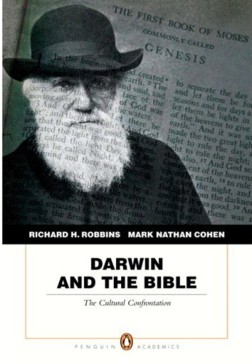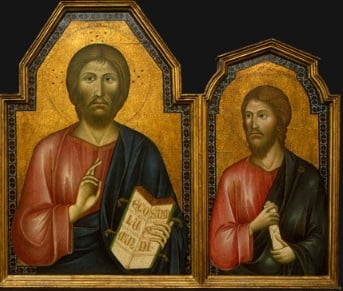
A couple of months ago we had two posts based on a book Darwin and the Bible: The Cultural Confrontation
– (first, second). This book was designed (with only modest success) to “help readers understand the nature, history, and passions behind the debate between scientific and religious versions of creation and human origin.” Today I would like to return to this book and address the concerns of the penultimate chapter.
Chapter 13 of Darwin and the Bible
is titled quite succinctly “Turmoil.” This chapter was written by Laura Perras, at the time a first year student at SUNY College Plattsburgh. Raised in a religious, antievolutionist background attending public schools and a public University, her emphasis in this essay is on the turmoil caused by the current debates, approaches, and language. Her point of view:
Evolution or creationism? That is the ultimatum that has prompted the war over what should be taught in American classrooms. This ongoing battle, as chaotic as the primordial waters, had been brewing for many years now. … Similar to a hurricane over the gulf, it keeps circling and striking land from numerous angles. The controversy of evolution versus creation is here to stay and students are going to need more than rain ponchos to protect themselves from the crashing waves. (p. 176)
Here is the question I would like to consider today:
Is “turmoil” a common experience? If so, what can we do to help students, in high school, college, and beyond, weather the storm? How do you think these issues should be approached in public schools? Do you think Christian schools should present “both sides”?
Perras describes her upbringing (northern USA, Methodist, not fundamentalist), her initial inherited view of creationism (typical young earth variety), and the experience of confrontation.
My own public education, although exceptionally good, spawned these feelings of frustration and confusion. I distinctly remember a particular lesson in my seventh grade science class. The teacher was showing us slides, describing different beliefs that humans have come up with in regard to human origin. The first was of a woman, a man, a tree, and a red sky. The instructor called it the “creation myth” and on hearing those words, I felt the hair on my arms stand on edge. I remember thinking: “Myth? What is he talking about? It is not a myth! He’s wrong!” I was deeply confused by the fact that one of my teachers would try to discredit the lessons I had been taught in Sunday school. … I adopted the use of a wall. This wall, similar to the Casparian strip in plant cells, prevents things from going in and coming out. I closed my mind to evolution, refused to learn about it, and kept telling myself that creationism was 100 percent correct. (p. 180)
Several years later a senior project (attempting to prove that creationism did work and evolution was just a guess) led to discovery of a number of problems: Genesis 1 and 2 are not entirely compatible stories of creation; evolution at some level did exist and undeniably; and Christians have various views on the topics. Perras wound up defending a day-age, microevolution view in her project. By the end of her first year of college when this essay was written she was leaning toward theistic evolution as an approach to the issues of science and faith.
Perras concludes her essay with a call for reason:
It is imperative that students learn about evolution, but it is also important that they are given a chance to learn about their faith. Both needs are equal. Students do not deserve to be given an education that neglects one approach and asserts another belief that is contrary to their religious beliefs or scientific studies. Compromises can be made. (p. 184).
This problem – the “conflict” between science and faith – is often given as part of the reason for loss of faith (see the chapter on apostasy in Scot’s book Finding Faith, Losing Faith: Stories of Conversion and Apostasy for some discussion and personal stories). Turmoil certainly describes the experience of some people.
Does “turmoil” describe your experience?
What is the appropriate approach to the creation controversy in our world today
- in our families
- in our schools (including home schools)
- in our churches
- on College and University campuses?
In your experience what works – and what doesn’t?
And now I will really step into it (this book arose in large part out of the Dover, Kansas, and Texas controversies over ID in the middle of the decade):
Does the discussion of Intelligent Design (that
intelligent design was involved and that the effects of this design are
empirically discernable) help or hurt?
If you wish to contact me directly you may do so at rjs4mail [at] att.net.


